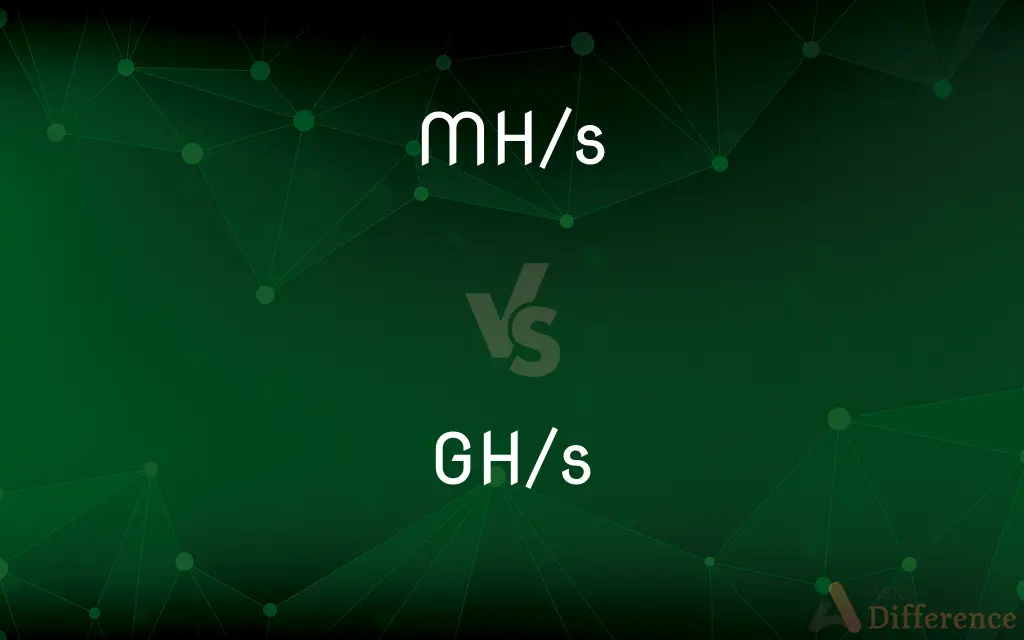MH/s vs. GH/s — What's the Difference?
By Tayyaba Rehman & Fiza Rafique — Published on February 6, 2024
MH/s (Megahashes per second) and GH/s (Gigahashes per second) measure computing power for cryptocurrency mining; 1 GH/s equals 1,000 MH/s.

Difference Between MH/s and GH/s
Table of Contents
ADVERTISEMENT
Key Differences
MH/s stands for megahashes per second, representing a unit of computational power that executes one million hash operations per second. This measure is crucial in the context of cryptocurrency mining, where miners solve complex mathematical problems to validate transactions and secure the network. MH/s is a measure of the mining hardware's efficiency and speed, with higher values indicating faster processing capabilities.
GH/s, or gigahashes per second, denotes a higher level of performance, equivalent to one billion hash operations per second. It's a unit that signifies an even greater mining capacity compared to MH/s. In the rapidly evolving field of cryptocurrency mining, GH/s has become a more common benchmark for modern mining equipment, reflecting the advancements in technology that enable more efficient and faster hash computations.
While MH/s is sufficient for describing the capability of entry-level and consumer-grade mining setups, GH/s is typically used when referring to more powerful and industrial-scale mining operations. The transition from MH/s to GH/s in mining hardware indicates a significant leap in technology and investment, aiming to achieve higher profitability and efficiency in mining activities.
The difference between MH/s and GH/s essentially boils down to scale and efficiency. Mining hardware operating at GH/s is more likely to generate higher earnings in a shorter amount of time, given the same network conditions. This is because a GH/s unit can process a thousand times more hashes per second than an MH/s unit, directly impacting the miner's ability to solve cryptographic puzzles and earn cryptocurrency rewards.
In summary, both MH/s and GH/s are critical measures in cryptocurrency mining, reflecting the computational power of mining hardware. The choice between the two often depends on the miner's budget, goals, and the specific cryptocurrency being mined. As technology progresses, the efficiency and speed of mining equipment continue to increase, pushing the boundaries of what is measured in MH/s and GH/s.
ADVERTISEMENT
Comparison Chart
Computational Power
1 million hash operations per second
1 billion hash operations per second
Mining Capability
Suitable for entry-level and consumer-grade
Preferred for industrial-scale operations
Technology Level
Indicates basic to moderate mining equipment
Signifies advanced mining technology
Efficiency
Lower compared to GH/s
Higher, resulting in potentially greater earnings
Usage
Common in early days or less intensive mining
Used in modern, more intensive mining operations
Compare with Definitions
MH/s
Reflects the efficiency of consumer-grade mining hardware.
Upgrading my GPU increased my setup's power to 50 MH/s.
GH/s
Represents advanced mining technology for higher efficiency.
My latest mining rig boasts a power of 30 GH/s, significantly increasing my earnings.
MH/s
Determines the potential earnings from individual mining operations.
With 100 MH/s, I can mine smaller altcoins profitably.
GH/s
Measures mining capability at 1 billion hashes per second.
High-end ASIC miners can achieve speeds over 10 GH/s.
MH/s
A performance indicator for less intensive cryptocurrency mining.
Entry-level miners typically operate in the tens to hundreds of MH/s.
GH/s
Essential for competitive mining in popular cryptocurrencies like Bitcoin.
Successful Bitcoin mining now requires hardware with hundreds of GH/s.
MH/s
Marks the computational power necessary for early-stage mining.
Initially, Bitcoin mining was achievable with just a few MH/s.
GH/s
A benchmark for industrial or large-scale cryptocurrency mining.
Our mining farm's total capacity exceeds 1,000 GH/s, contributing significantly to the network's hash rate.
MH/s
Unit measuring mining speed of 1 million hashes per second.
My new mining rig achieves a stable 20 MH/s on Ethereum.
GH/s
Indicates the scale and potential profitability of mining operations.
To compete today, miners need equipment rated in GH/s.
Common Curiosities
Is GH/s always better than MH/s for mining?
Generally, yes, because it indicates higher computational power, but it also depends on electricity costs and the cryptocurrency being mined.
How do MH/s and GH/s relate to mining profitability?
Higher values in either MH/s or GH/s can lead to greater mining earnings, depending on the cryptocurrency.
What does MH/s stand for?
It stands for megahashes per second, a measure of mining speed.
Can I convert MH/s to GH/s?
Yes, 1 GH/s equals 1,000 MH/s.
What does GH/s represent?
GH/s stands for gigahashes per second, indicating a higher level of mining speed.
Do all cryptocurrencies use MH/s or GH/s for mining?
Most do, but the preferred unit depends on the difficulty and algorithm of the specific cryptocurrency.
How do I calculate my mining rig's speed in MH/s or GH/s?
Mining software typically displays your rig's hash rate in real-time.
Will MH/s become obsolete in mining?
For some cryptocurrencies, yes, as the difficulty increases, but MH/s may remain relevant for less popular or newer coins.
What kind of hardware operates in GH/s?
Advanced ASICs and high-end mining equipment.
What equipment typically uses MH/s?
Consumer-grade GPUs and older mining rigs.
Can upgrades to mining rigs move them from MH/s to GH/s?
Significant upgrades or switching to ASIC miners can achieve this.
Does a higher GH/s guarantee mining success?
Not necessarily, as profitability also depends on electricity costs, mining difficulty, and market conditions.
How has the shift from MH/s to GH/s impacted mining?
It reflects technological advancements and increased competition in mining.
What's more cost-effective for a beginner, MH/s or GH/s?
Starting with MH/s-level equipment is more accessible and cost-effective for beginners.
Is it worth investing in GH/s-level equipment for a small-scale miner?
It depends on the miner's budget, electricity costs, and the chosen cryptocurrency's potential profitability.
Share Your Discovery

Previous Comparison
Dhirubhai Ambani vs. Ratan Tata
Next Comparison
WWE RAW vs. WWE SmackdownAuthor Spotlight
Written by
Tayyaba RehmanTayyaba Rehman is a distinguished writer, currently serving as a primary contributor to askdifference.com. As a researcher in semantics and etymology, Tayyaba's passion for the complexity of languages and their distinctions has found a perfect home on the platform. Tayyaba delves into the intricacies of language, distinguishing between commonly confused words and phrases, thereby providing clarity for readers worldwide.
Co-written by
Fiza RafiqueFiza Rafique is a skilled content writer at AskDifference.com, where she meticulously refines and enhances written pieces. Drawing from her vast editorial expertise, Fiza ensures clarity, accuracy, and precision in every article. Passionate about language, she continually seeks to elevate the quality of content for readers worldwide.
















































